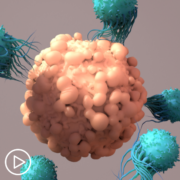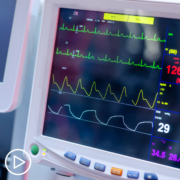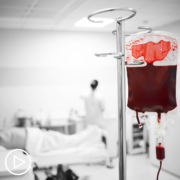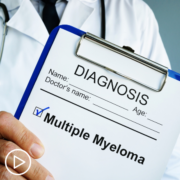How Can You Engage in Your Myeloma Treatment Decisions? from Patient Empowerment Network on Vimeo.
Myeloma expert Dr. Benjamin Derman shares advice for partnering with your team when choosing a myeloma therapy, discusses important factors that should be considered, and provides key questions to ask your healthcare team to help you engage in your care. Dr. Derman also reviews research updates from the December 2022 American Society of Hematology (ASH) meeting.
Dr. Benjamin Derman is a hematologist and oncologist specializing in multiple myeloma at the University of Chicago Medicine Comprehensive Cancer Center. Learn more about Dr. Derman.
Download Resource Guide
See More from Engaging in Myeloma Treatment Decisions
Related Resources:
Transcript:
Katherine:
Hello and welcome. I’m Katherine Banwell, your host for today’s program. Today we’re going to talk about myeloma treatments, what the options are both current and emerging, and how you can play a role in your care and treatment decisions.
Before we get into the discussion, please remember that this program is not a substitute for seeking medical advice. Please refer to your healthcare team about what might be best for you.
Well, let’s meet our guest today. Joining me is Dr. Benjamin Derman. Dr. Derman, welcome. Would you please introduce yourself?
Dr. Derman:
Yeah. Thanks so much for having me. As you said, my name is Ben Derman. I’m an assistant professor at the University of Chicago. And I specialize in actually, plasma cell disorders, which is mainly multiple myeloma, amyloidosis, Waldenstrom’s. If a plasma cell is the problem, then I address it. So, that’s what I do. And that’s my clinical and research focus as well.
Katherine:
Excellent. Thank you so much for taking the time to join us today. Before we get into our discussion about available myeloma treatments, let’s talk about emerging therapies. And I know there are many.
The American Society of Hematology or ASH annual meeting took place in December. What are some of the highlights from that meeting?
Dr. Derman:
Yeah, ASH is always a very exciting time because it’s when we get to see all the latest and greatest of what’s on the way or what’s already here to stay.
I think the biggest focus in the myeloma field, if I could really pin it down, was more in the later stages of the disease and focusing on treatments in that setting. We already have two FDA-approved chimeric antigen receptors, or CAR T-cell therapies, in Ide-cel (Abecma), and Cilta-cel (Carvykti). Those are the brand names. And then more recently, we just had a bispecific antibody, which is another type of immune therapy that was approved. But there are actually many under investigation.
And so, at this ASH we heard a lot. Not only about the target that’s been most popular in this setting, which is something called BCMA or B-cell maturation antigen.
That’s what the CAR T-cell therapies that I mentioned are going after and the teclistamab (Tecvayli) bispecific antibody that I mentioned.
But there are a lot of other candidate drugs that are also targeting that same molecule. So, we heard a little bit about – more about those. We’ve been hearing about them pretty much at every conference these days.
So, there’s a lot of competition in that space. Which is good for patients because ultimately, what we’re trying to figure out is, is one of these better than the others? Or at least, if we have multiple options, there may be different side effect profiles that we have to think about.
But now as BCMA therapies are getting used more and more, one of the questions is, well, is there any other target that we could go after? And really, the one that was hot at ASH this year was something called GPRC5D, or G-protein coupled receptor 5D. This is expressed pretty strongly in myeloma cells, and not in many other tissues. Maybe the skin, nails, tongue. So, basically, that’s what you want, is you want a target that’s not going to be expressed elsewhere.
So, there were a couple of different types of therapies that were discussed. One was a CAR T-cell therapy going after GPRC5D, and the others were – there were two bispecific antibodies actually targeting the same GPRC5D. And that’s actually already in addition to another GPRC5D directed bispecific that’s in development.
So, basically, the idea is that if patients may experience progression on one of these BCMA targeting agents, we’re going to have another target to be going after. And I think that part is really, really exciting.
And as far as other highlights, I think the other thing is, how do we reduce the toxicity from these drugs? And exploring avenues in order to be able to decrease sort of the inflammatory effects of these drugs, which are important.
Katherine:
That’s great. It sounds so promising. And all of that information is going to be very helpful as we move through today’s discussion.
Let’s start with a general overview of treatment options. What types of treatment are offered for myeloma patients?
Dr. Derman:
Right. So, if you think about at the point where a patient is diagnosed with myeloma, unfortunately, always a tough – always tough news to receive and to share with patients as well, we start to think about dividing treatment into phases. And in part, some of it’s going to depend on, what is the fitness level of a patient in front of me? And not so much age per se, but really fitness level. And what I mean by that is independence in their activities of daily living, their ability to walk, go up flights of stairs, carry out just their daily life.
So, assuming that all options are on the table, we consider those patients to sort of be what we call stem cell transplant-eligible.
And that picks a sort of variety of pathways that we can go down. And then the other variety of pathways we can go down are patients where either because of a comorbid conditions, there are other medical problems, or because of their fitness level, a stem cell transplant is not really going to be something that we consider.
But either way, in either case, we start with something called induction therapy, where we’re aiming to induce a remission. Or induce a response as we typically say more commonly in myeloma.
And usually that involves a combination of three or now possibly four drugs. And it’s really, really different the way that we treat myeloma than we treat other cancers. And what I mean by that is the traditional thought of using very harsh chemotherapy drugs that make people feel very sick, very ill, lose their hair, those kinds of things. Things that are maybe more outwardly associated with chemotherapy, we don’t see that with myeloma.
In fact, I often tell patients if they’re fortunate to not have the disease affect them so much at diagnosis, a lot of people may not even know that they’re on treatment. And that can be good and bad, because they don’t know that what you’re going through, which can be challenging in its own right.
So, really what we use are a combination of therapies. They can be oral drugs, they can be subcutaneous injections under the skin, or infusions. And one of the newer advances is using immunotherapy in myeloma. And this is a little different than it is in solid organ cancers like lung cancer or melanoma where immunotherapy is very popular as well.
One of the main targets that we go after is something called CD38 on the surface of myeloma cells. And CD38 can be targeted with a type of monoclonal antibody.
And there are two that are out right now, daratumumab (Darzalex) and isatuximab (Sarclisa). Daratumumab is actually approved to be used in the frontline setting, meaning at diagnosis. And that has really allowed us to augment the already – the backbone that we’ve been already using for quite some time in myeloma.
Dexamethasone (Decadron), which is a steroid, is typically employed in all of these cases. And then we use drugs that are in the class of what’s called immunomodulatory iMiDs, chiefly lenalidomide (Revlimid) is the main one that we use in oral drug, and that’s been approved since 2006 or so.
And then bortezomib (Velcade), which is something called the proteasome inhibitor, or its cousin carfilzomib (Kyprolis), can be used as well in the frontline. So, we’re usually combining these three or four drugs together in order to create this sort of symphony that really targets the myeloma from many different aspects.
Katherine:
Yeah. How do patients know if they have any of these targets, such as CD38?
Dr. Derman:
So, actually it’s interesting. CD38 is pretty much ubiquitously exposed on the surface and expressed on the surface of myeloma cells. So, it’s in a pathology report. It’s actually one of the ways in which we can identify what makes a plasma cell a plasma cell. But CD38 is one that is essentially ubiquitously expressed.
And I say that with the idea that that expression may go down if you use these drugs to target that specific – that target. So, as time goes on, it’s not a drug that you may be able to reuse over and over. Or at least there might need to be a nice long break.
Katherine:
So, obviously there are very – there are a lot of available therapies for myeloma. And I’m wondering what factors might impact treatment decisions. You did mention comorbidities. But what other factors are there?
Dr. Derman:
Sure. And I think in part, it depends on if we’re talking about induction therapy or in the relapsed refractory setting. Let’s focus on induction therapy, right?
So, there are some drugs that we’re typically going to employ pretty much universally. For those who are inclined to use that CD38 monoclonal antibody that I mentioned, it pretty much plays well with patients of all walks of life. So, that’s one where I feel really comfortable regardless.
Lenalidomide is a drug that we don’t necessarily know from the get-go if there’s going to be a patient that’s not going to tolerate it well.
We might reduce doses up front. But for the most part, that’s another drug that we’re typically going to use. I would say the one exception is for patients who have a simultaneous diagnosis of amyloidosis. And we know that in amyloidosis, lenalidomide may not be as well-tolerated.
But actually, one of the key decisions that I’m often making in clinic myself is around that drug class that I mentioned earlier called proteasome inhibitors. And I mentioned two different drugs. There’s bortezomib and carfilzomib. And they actually come with very different side effects that I think are important to mention.
Bortezomib is one that is typically associated with a high rate of numbness and tingling, what we call neuropathy in the fingers and toes. And about 75 percent of patients have been reported in the trials to get this. And most of it is what we call lower grade. But I’m not in the patient’s body, and I don’t know what that – what even a grade 1, which would be the lowest grade, really feels like. And if I have a mechanic, somebody who types for a living, a surgeon, somebody who uses their hands or their or rely on their feet for their day-to-day, that’s a scary prospect, right?
The flip side is this drug, carfilzomib, is one that does not really cause nearly as much neuropathy, but has been associated with cardiac effects. Heart issues. And so, that can scare people, right? Heart’s important I hear. So, we have to be really careful in how we pick these therapies and talk about it with patients.
Katherine:
Yeah. When we talk about making treatment decisions, it’s important to choose a therapy with your healthcare team.
Let’s share some tips for having that conversation. I’d like to start with induction therapy, which is the first line of treatment for patients. What questions should patients ask when choosing therapy early in their diagnosis?
Dr. Derman:
Yeah, that’s a great question. And it’s of course – it’s really the patient priorities I would say. So, one of the things that I like to discuss with patients is, number one, what are the things that they value? And that’s a hard question to ask without any qualifiers.
So, one of the things that I often ask patients to think about is the – first of all, the number of visits to the medical center. Certain therapies are weekly, certain therapies may actually decrease in frequency overtime. So, if that is something, it’s hard to travel, it’s hard to get someone to take you or to come yourself, or you just don’t want to be in the clinic as much – right? If that’s your number one priority, there are going to be certain therapies that are – or regimens that may be better suited for that patient. If somebody says, “I don’t care how many times I have to come, my goal is the deepest response possible,” you can think about things from that standpoint.
I mentioned side effects. What are the things that are scary to you personally, as a patient? Some people may look at that neuropathy, as I mentioned, and say “No way. That sounds horrible. I can’t do my job.” Other people would say, “I already have some cardiac issues. I don’t want to take that risk.” Right? So, there are different side effects that we have to take into account.
Especially when it comes to talking about transplant, there is not just the acute issues that we have to deal with in terms of side effects, but also long-term immunosuppression. Meaning the immune system is suppressed, and there’s a risk of infections, and it’s going to be higher than if you had not gotten a transplant. So, those are at least some of the things that I encourage patients to be thinking about.
I would also say, on top of that, patients may be approached about clinical trials. And I work at a university where we really value enrolling patients in clinical trials. But that they do come with some inconveniences as well, even though I think they really help to advance the field forward, and sometimes offer patients options they wouldn’t normally be able to get. But there are typically more visits associated with that, more evaluations, more blood draws, more bone marrow biopsies, so those are things that you really have to take into account.
Katherine:
That’s great advice, Dr. Derman. Unfortunately, relapse is common among myeloma patients. Or it may be that a treatment stops working, and so the person’s myeloma becomes refractory.
When considering a treatment for relapsed or refractory myeloma, are there different questions that patients should be asking their healthcare team?
Dr. Derman:
Yeah. I mean, that’s a great question. I think part of it is every patient’s journey with myeloma ends up being quite unique, in part because we don’t have a lot of consensus in terms of how to treat myeloma. So, I may choose one regimen, but the other doc down the street is going to recommend a slightly different one. And now, they all have efficacy. No one’s going to be recommending something that’s not good, right? But what it means is that the journey, the number of therapies, the types of therapies that a patient has received are all going to be quite different than the next.
So in part, sometimes the past therapies are going to dictate what options are available.
So, I mentioned some different classes of therapies. The proteasome inhibitors, there’s a certain number of those. The immunomodulatory iMiDs, there’s a certain number of those. The CD38 monoclonal antibodies, there are those. And then there are a few other drug classes as well.
And if we’re using three or sometimes four drugs at a time for each what we call line of therapy, meaning each time a patient changes treatment – right? Eventually, we’re going to have gone through a number of treatments that now the patient would be – their disease would be resistant to. And so, you don’t really – it’s not really going to be prudent or wise to go back to therapies that didn’t work previously.
And so, we start mixing and matching, and we come up with regimens that we think are going to hopefully throw a curveball to the myeloma to really try to get rid of it again. That’s what I mean by it’s dictated by past therapy.
Katherine:
Is research being done to determine the likelihood of relapse and when that might occur?
Dr. Derman:
Yeah. I mean, we can look at clinical trial data for regimens that have been tested in the relapsed or refractory setting and say, “Okay, we know that this three drug regimen typically gives patients a year before the disease comes back.” Or “This one gives two-and-a-half years or three years.” So, that’s one piece.
But when you think about who – if you wanted to know ahead of time, “Okay, a patient with high-risk disease, they’re likely not to have as good of a response.” But nobody knows ahead of time the exact amount that they’re going to relapse.
But one of the things that we focus on, part of the reason that patients get a good amount of blood work when they have myeloma and they’re on therapy is that we have a measure in the blood, or we have several measures in the blood, where we can monitor for relapse. So, we can look at the abnormal proteins, what we call paraproteins in the blood. Either as the M-spike, is what it’s called, or light chains. We look at both of those to see if there are increases in those numbers over time.
When a patient’s responding, those numbers come down. When a patient is losing response and their disease is progressing, that’s when we start to see those numbers go up. And that’s often an indication that we need to switch treatment, even before a patient develops symptoms related to their myeloma.
Katherine:
When a patient goes into remission, they’re often placed on a maintenance therapy. What’s the role of maintenance therapy in myeloma care?
Dr. Derman:
Yeah. So, maintenance, just to specify, is typically something that we call a long duration of usually, less intensive therapy after a more intensive schedule of therapy. So, the most common area that we talk about maintenance is after, let’s say, an autologous stem cell transplant, which came after induction therapy that I mentioned.
But for patients even who don’t go to a stem cell transplant, they can also go on maintenance therapy. So, when we think about the frontline setting, which in this case would be induction transplant maintenance, the most commonly used drug is a single agent lenalidomide. And that’s been shown to have survival benefits not just in keeping the disease away, but also helping patients live longer. So, maintenance therapy does seem to carry some real importance. One of the things though that we don’t know, is really how long patients need to be on maintenance therapy.
So, we can all accept I think in the myeloma field, if there’s one thing we can agree on, is that maintenance is important. But the question is, what makes up that maintenance therapy? And then how long? Those are questions we don’t really have the best answers to. And actually, one of the areas that I do quite a bit of research in is about this, how long do patients need to be on therapy?
So, we recently published some – we presented at ASH this year in 2022, some recent data, at least a preliminary data on patients who had really deep responses, and who we stopped their maintenance therapy after at least one year – but the average was about three-and-a-half years on maintenance therapy – to see if the disease would actually be at risk of coming back.
And so, what we’re finding is that even in the first year, about 85 percent of patients did not have their disease come back after stopping therapy. So, maintenance therapy is certainly important, but I think we still have to figure out how long patients need to be on that therapy.
Katherine:
Right. And I can imagine that each person, each patient is different, and some – the maintenance therapy would work really well for them for a long period of time. For others, not necessarily.
Dr. Derman:
Yeah. I mean, a lot of it comes down to the risk there of the patient’s myeloma. And what I mean by that is – so, somebody has explained to me previously, and I really like the analogy that myelomas are kind of like people. They have different personalities, and they give first impressions. And sometimes your first impression of a myeloma may end up being wrong. You thought it was going to be really hard to treat and you found out that it actually responded pretty nicely to therapy. And other times, it’s the other way around.
But for the ones that give us a bad first impression, we’re going to be treating those patients typically more aggressively. At least that’s my personal approach. And I take that all the way through from induction, to transplant, even into maintenance therapy where I mentioned already, most people will prescribe a single drug as maintenance therapy. But for those patients, I’m typically going to be prescribing more than that. Or I will continue more aggressive therapy for longer. So, that’s where you have to sort of adapt your therapy in some cases to the patient and their disease characteristics.
Katherine:
Related to maintenance therapy, we received this question before the program. How do doctors feel about maintenance breaks if you are MRD-negative? Or in a very good response?
Dr. Derman:
So, I want to be very careful about how I respond to this. Because what I’m going to say is, there’s currently no data to tell us that patients should stop. I mean, in part that’s, you should stop therapy. In part that’s what I’m hoping that we can answer with our study. There’s another large cooperative group study trying to answer this as well, about the duration piece and whether people can stop.
So, a very good partial response signifies at least a 90 percent reduction in the tumor, in the myeloma, but not 100 percent.
And there’s also a complete response, which means there’s no detectable disease by conventional methods in the bone marrow or in the blood, but that there can still be microscopic or low levels of cancer cells which we call minimal residual or measurable residual disease. Also called MRD.
So, MRD negativity is a not so nascent field now, where we are trying to quantify small amounts of cancer cells that may still be present. And the theory is that the presence of residual disease at a small measurable level is what’s ultimately responsible for myeloma relapsing.
We used to think like, “Oh, a patient is in a complete response. That’s amazing. Let’s clink our champagne glasses. Let’s celebrate.” And there’s still cause for celebration for that. That is a great achievement. But we know that that doesn’t mean we can rest on our laurels. If there is MRD-positive disease, then the disease, it can likely come back. And that’s where suppression of the disease with something like maintenance therapy with lenalidomide is probably helping a lot.
Katherine:
Yeah.
Dr. Derman:
But let’s say we have people who don’t have detectable disease, the question is, can they stop? And like I mentioned, we’re trying to answer that question. I would say right now, there’s no recommendation for that. I can’t say in good faith that you should be doing that, unless it’s as part of a clinical trial, which is what we’re hoping to answer.
Katherine:
Let’s get to a few audience questions, Dr. Derman.
Craig sent in this question prior to the program. “My primary side effect is fatigue.” And you just mentioned that. “What advice do you have for planning activities through the day?”
Dr. Derman:
So, this is a very common side effect that we see. In part, it can be from the disease itself. And if that’s the case, it’s going to get better as treatment works. In other cases, it’s due to the treatment itself. And sometimes there are controllable aspects. If it’s a pill, let’s say, where you can control the timing of when you take it. I often tell patients, “Take the drug at night. Because if it makes you tired, at least you’re going to be going to sleep at that point.”
I do think making sure that you have a good night’s sleep is important. I think making sure that you keep your day-night cycles. So, even if you feel fatigued and you’re at home, it’s not good to be having the windows closed and not being exposed to the outdoors at all. You need light during the day. That’s a normal human need. We do the same thing when patients are in the hospital, and it’s very easy to get your day and night cycles messed up.
And the other thing too is planning periods of the day when you know that your activity level is going to be, or your energy level is going to be higher, and planning your activities around those times. I think those are at least some important things that we can do.
Katherine:
Yeah. Lauren wants to know, what is the best way to measure current immunity status? And should we mix COVID vaccine and flu vaccine?
Dr. Derman:
Mm-hmm. This has become sort of a hot button issue all of the sudden over the last few years. Well, so, as far as immunity status, I wish there was a one good test that we could know.
I mean, there are some features. Patients who have low white blood cell counts, especially low neutrophil counts, are certainly going to be at higher risk for infection. And that can happen due to myeloma, or more commonly, due to therapies. We can look at immunoglobulin levels, especially the IgG level. Patients who have IgG levels typically less than 400 milligram per deciliter seem to be historically at higher risks of infections. So, something called IVIG, which is an infusion of donated antibodies from plasma from healthy donors, can be used for that.
There’s been a lot of discussion about, how do we know immune status related to COVID? And there are antibody levels that can be checked, but the truth is nowadays most people have high antibody levels, even if they’re on therapies because of the number of vaccines they received or natural infection. And it may not be a really good surrogate for understanding immunity to COVID. COVID’s outsmarted us time and time again, and probably will continue to do so.
As far as the vac – I mean vaccines are super important. We do this for all our patients after transplant as well, revaccination them for all of their childhood vaccines. As far as the COVID and flu, I personally – I’m happy and feel fine administering both at the same time. We’ve seen no real safety signals there in my anecdotal experience. But I’m perfectly fine if patients want to split them up. It’s not something that is a 10 out of 10 for me. It’s more that it is as long as they’re getting both, I think that’s really important.
Katherine:
Yeah. One final question for you. Jennifer asks, “Many new medications for treatment were mentioned. And I’m sure these could be expensive. What are the options to make these available financially for patients who need them?”
Dr. Derman:
That’s a really good question, and one that we don’t yet have great answers to. As a physician, I don’t receive compensation based on the drugs that I prescribe. And so, I do know – I often have a good sense of what these drugs cost. A lot of the costs that are passed along to patients typically revolve around oral therapies. Even patients who are on Medicare, or sometimes especially patients who are on Medicare. And looking at some of the policy changes that seem to be coming down the pike that include capping Medicare out of pocket costs for medications will be a huge benefit to our myeloma patients.
It’s important to familiarize yourself with different organizations and the financial support that may be available. Just to name a few, and you’re not limited to these, but The Leukemia & Lymphoma Society does a really great job in providing financial support to patients. But there are definitely other programs that can be contacted for this.
And also, a lot of the pharmaceutical companies will actually have patient assistance programs as well. Sometimes it’s as simple as asking your provider, and typically they will have their team look into this for you. But we’re fortunate to have a team of pharmacists and my nurses as well who are used to doing this kind of thing. So, it’s important to look into those as well.
Katherine:
Right. And so, there are lots of resources out there, it’s just asking your healthcare team what they are. Right.
So, these were all really great questions, and we ask our audience to continue sending in questions to question@powerfulpatients.org. And we’ll work to get them answered on future programs.
Dr. Derman, what advice do you have for patients? What would you like to leave the audience with?
Dr Derman:
You know, myeloma is a funny – it’s a funny disease in the sense that patients who were diagnosed 10 years ago, who I still see, they remind me of the action movie where the building is maybe blowing up in the background, blurred out, and they’re running out of the building just in time. And that is because the pace of progress is fast enough in myeloma that we have all these new therapies coming down.
So, really, I think maintaining hope and thinking about – don’t worry so much about what’s going to happen next. Figure out what you’re going to do now, and make sure that you’re living your best life now, and making sure that you’re doing what you can to treat your disease, I think, and help you feel good during that period too.
Katherine:
Yeah.
Dr. Derman:
So, I think it’s a message of hope mainly, that I feel really good about the future of myeloma. There’s a lot of innovation in this space that you can feel good about.
Katherine:
Yeah. Dr. Derman, thank you so much for joining us today. It was a pleasure talking to you.
Dr. Derman:
Likewise. Thanks so much.
Katherine:
And thank you to all of our partners.
To learn more about myeloma and to access tools to help you become a proactive patient, visit powerfulpatients.org. I’m Katherine Banwell. Thanks for joining us.































